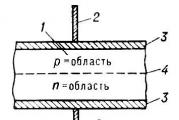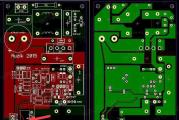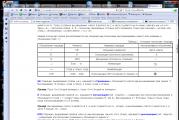DWM EXE process How to disable launch. What is Windows Dispatcher and why he loads the processor
In Task Manager Windows Users DWM.exe process can detect. Desire to better understand system Programs Misses to find out what kind of DWM.exe process? What functions and tasks does it perform?

In this article, we will deal with the main issues relating to this process and also consider some problems that may arise with it.
dWM.EXE - Windows Desktop Window Dispatcher
What is the process of dwm.exe and what functions it performs:
dwm.exe. - This is the desktop window manager (D Esktop W Indows M Anager). It is responsible for the correct graphical display of windows, 3D effects, topics and support for high-resolution displays. Present in the versions of Windows 7, 8, 10, Vista.
dwm.exe - where is the source file
The location of the source file application dwm.exe:
C: \\ Windows \\ System32

User DWM-1 and DWM-2 - What is it?
The task manager may display DWM-1 and DWM-2 processes. This happens when several accounts are present on one PC. The numbers indicate the user ID.
dwm.exe loads processor: how to fix
dwm.exe is system process operating system. And in normal conditions, it should not create high loads. If dwm.exe loads the processor, this may indicate malfunctions in the operation of the OS.

Error "Files of Files DWM.EXE": how to fix
If the error "The name of the DWM.exe failure application" error appears, then the reason for its occurrence may be:
- Lack or malfunction Direct X;
- Lack or malfunction of video card drivers;
- Fault video card.
To fix it, you must reinstall the Direct X and the driver on the video card. You also need to test the video card with special programs For stress testing.
How to disable dwm.exe
dwm.exe is a systematic windows application And it is not recommended to disable it. Its deactivation can lead to improper display of the desktop windows. In particular, will be disconnected windows mode Aero, and the interface will switch to simplified mode.
How to disable dwm.exe:

Desktop Window Manager (DWM.exe) is a window layout manager that allows you to create all these beautiful effects In Windows: Transparent windows, live sketches of taskbar, Flip3D and even high monitor resolution.
Thanks to the DWM.exe process, applications are first drawn to a certain place in memory. The Windows then creates one "composite" view from all windows on the screen before sending it to your monitor.
Thanks to the computing, Windows can show the contents of each window, as well as add effects, such as transparency and animation of windows.
Is it possible to disable desktop windows manager
No you can not! Since the times of Vista Controlled using the service that could be turned off - and, in turn, turn off all visual effects.
Starting with Windows 7, the desktop window manager has become an integral part of Windows, since it became "vital" to create a graphical user interface. Integration is even more deepened in Windows 8 and 10.
The good news is that the window manager has become much better and learned to efficiently manage resources, therefore there is no meaning in its disconnection.
What to do to reduce the load on memory and processor
Desktop Window Manager uses enough enough system resources. On my system where a dozen active applications are launched, including a chrome with a dozen open tabs, Desktop Window Manager uses 0.1% of the processor resources and about 36 MB random access memory. This is a rather typical load.

If you see that the desktop window manager consumes a lot of RAM or processor resources, it is worth perform the following steps:
- Make sure your drivers are updated, especially drivers for a video card or an integrated graphics adapter. The desktop window manager transfers most of the GPU processes to reduce the load on the central processor.
- Check your computer for malicious programs. Some types of malicious programs cause problems with the desktop windows dispatcher.
Can DWM.exe process be a virus
The process of the desktop windows manager itself is the official components of Windows. Although it is possible that the virus replaced the real process, but it is very unlikely.
If you want to be sure you can check the source of the process. In the Task Manager, right-click on the Desktop Window Process and select item. Open the file location.
If the file is stored in the Windows \\ System32 folder, then you can be sure that you do not deal with the virus.
However, if you are still worried about security, you can always check the computer for viruses with antivirus scanner.
Desktop Window Manager (DWM.EXE) or desktop windows manager - The process that is displayed in the Task Manager and gives an amazing view of your windows. This process supports Flip 3D, support for high resolution, real-time miniatures, transparency effects. This is a built-in Microsoft Windows 10 OS feature that helps control the various desktop screen functions. When you turn your computer, you see animation, 3D effects, visual expressions, etc. All these functions are monitored by this process, component, file. This is genuine system file. from Microsoft, not a virus, as many people think. DWM.exe itself is official windows component, so he cannot cause any problems.
Sometimes you may find that the dwm.exe file is shipping CPU. If you find this file in your way c: \\ Windows System32, this is not a virus. However, if you find any other file with the same name and extension in any other folder, it may be a malicious software. To find out the folder finding any file, simply right-click and click " Open the file location".
How does dwm.exe work?
This is Windows Layout Manager and allows programs to record data according to their needs. Then it combines them into the final image and sends the entire schedule through the multimedia integration level before it is shipped to the video card. Thus, the video card gives you the desired view on the screen.
If you disable dwm.exe?
As you know that DWM.exe manages all the visual effects of your screen, there is no logic to turn it off. You will find the option in the Process Task Task Manager (DWM.exe), but since Windows uses high-resolution technology, so you do not automatically complete the process, and I do not advise.
dWM.exe High Using Memory and CPU in Windows 10
dWM.exe in Windows 10 takes a very small part of your system resources, approximately 0.4% of the processor and about 40 MB of RAM. It may be less or more depending on the screen resolution. Even during working with browsers and applications, you will notice the minimum use of resources.
Properties of file dwm.exe
- File Description - Desktop Window Manager
- Product Name - Microsoft OS
- Copyright - Microsoft Corporation
- Size - 61.0 KB
- File Name - DWM.EXE

Many users, facing the problem of system speed, launched the task manager in the operating windows system And discovered that the DWM.exe service is shipping the processor. This process consumes a large number of resources and causes a lot of issues from inexperienced users. So what is it - dwm.exe? What tasks involved this functionality and is it not a virus?
Dwm.exe - What is it?
Desktop Window Manager is the Dispatcher room layout service that displays all visual effects in Windows: the degree of transparency of the window, miniature icons on the taskbar, 3D visualization and high-resolution display support.
In previous versions of operating systems, the process was called as DCE (Desktop Compositioning Engine). When answering the question: "DWM.EXE process - what is it for what it is running?" The most optimal answer is: "This is a window manager in Windows Vista., as well as versions of OS with 7 to 10, which allows the use of hardware acceleration to visualize the graphical interface. "
Historical reference
Initially, the dispatcher was created to ensure the possibility of using new features such as Windows Aero, which made it possible to use transparency effects, three-dimensional windows switching and many other visual capabilities. DWM is also part of Windows Server 2008, but this requires the Desktop Experience function and compatible graphics drivers.
Dwm.exe - What is this process and how does it function?
Instead of applications displaying your displays directly on the screen, DWM writes a window image to a specific memory cell. Then the operating system creates a common, compiled, window type before sending to the monitor. The OS is able to compose and display the content of each window. This allows DWM service to add effects (transparency and animation).

Architecture
Dextopte window dispatcher is the layout service. The question arises: "DWM.EXE architectural solution - what is it?". Features of the service specification mean that each program has a buffer in which the data is recorded. The DWM then combines the buffer of each program to the final image. For comparison, the stacking window manager in Windows XP and more early versions (as well as Vista and Windows 7 with Windows Aero disabled) contains one display buffer in which all programs are recorded.
Implementation in different versions of Windows OS
DWM works differently depending on the OS properties (Windows 7, Vista) and from the version used graphic drivers. In Windows 7, the service records the program buffer into video memory, even if it is a graphic device interface program (GDI). This is due to the fact that Windows 7 supports limited hardware acceleration for GDI, and this does not need to save a copy of the system memory buffer so that the processor can write to it. In Windows Vista, the lunist was run by the service that the user could turn off, which limited the work of all visual effects. Starting with the 7 version of DWM, it became a mandatory part of the OS, which is important for implementing the graphical user interface.

Process Management
When the user first faces the windows linker, it is asked: "dwm.exe - what is it and can it be turned off?". Do it in modern windows versions 8 and 10 can not, since the service is deeply integrated into the OS and optimally controls the resources, which does not affect the critical speed of the personal computer.
Influence on resources
DWM uses the minimum volume of all PC resources. Simple example: There are several active applications in the system, including browser Google Chrome. With dozen tabs. Even in this case, the Layout Service consumes less than 1% of the CPU resources and about 60 MB of RAM. This is quite a full load. As a rule, if the "jumps" of resource intensity happens, they quickly return to normal.
If you see that DWM uses a larger amount of RAM or processor control, which is provided by the norm, follow several actions:
Make sure that updated video card drivers or an integrated graphics adapter are installed on your device. DWM redistributes a large amount of work on your graphic processorTo reduce the load on the CPU.
- Check the PC for malicious software. Some types of viral programs cause failures in the work of the linker.

Is this a virus?
DWM.exe service is the official component of the operating system. But a situation is possible when the virus replaces the real process of an infected executable file. To be sure that everything is in order, you need to check the location of the file. In Task Manager, click on the Desktop Window Manager process and select the Open File option.
If the file is located at the "Windows \\ System32" address, you can be sure that this is a regular process of not viral origin.
Desktop Window Manager. (Desktop Window Manager) is a window manager present in the Windows operating system from the release of Vista version.
Initially, it was created to add effect. Aero.Nevertheless, soon the functionality DWM It was expanded and it became an integral part of Windows.
Desktop Window Dispatcher Functions
As we said above, the main task dwm.exe. Is control of the desktop windows, it monitors the display of all pixels on the screen of your computer.
DWM can also be called the layout tool. Why? It uses collected from all at the same time open applications (browser window, conductor, etc.) graphic information and creates the final image that we used to see the usual set of windows.

DWM manages not only windows. It is also responsible for important system functions, such as visual effects, glass frames, screensavers, wallpapers, Windows themes, 3D animations and Windows Flip.
The main distinguishing feature of its last versions is the ability to save graphic data in different buffers. This allows you to introduce new modern functionsthat would not have the opportunity to run on old systems.
How to enable or disable DWM?
Before we proceed to the analysis of this topic, it is important to note that Desktop Windows Manager. became an important component of the operating system. Microsoft disabled any opportunity to deactivate it since the release of Windows 8. Nevertheless this service You can disable if you use Windows 7 or Windows Vista.
Using the key combination Windows + R., Enter the command services.msc. and press ENTER. Find the Desktop Windows Manager service (Desktop Manager) and disconnect it.
It does not require a lot of resources, so it should not interfere. However, if there are errors with visual effects, try to restart the computer.
DWM loads the processor or memory.
Some users complained that Desktop Windows Manager for some reason took an overly large number of computer resources. If you find out your situation, try the following:
Disconnect transparency
Go to section Personalization\u003e Colors. Scroll down the contents of the window closer to the end and change the value Effects transparency on the From.

Disconnect visual effects
An important step to reduce the load on DWM is to disable all possible Windows effects.
1. Right-click on the icon My computer (this computer).
2. Go to Properties.
3. Open Additional system parameters.

4. Open tab Additionally.
5. On the menu Speed Go to Parameters.

6. Install active Parameter state Provide the best speed.

7. Click Apply and OK.
These actions will significantly reduce the presentability of the external views of WindowsNevertheless, the load on DWM will be reduced, and the PC performance will increase.
Sourid app
There are many processes started third-party applications. As a result, they can directly affect the load capacity.
Remember whether you were not installed the other day new program - It is possible that the reason lies in this action.
Is DWM.exe virus?
A definite answer - not. By default, this service is in the folder. System32. System disk. If you discovered it in a wrong place, let's say this another logical partition, then it makes sense to turn on the alertness.
Scan the computer with Windows Defender or use third-party antivirus softwareTo eliminate a possible virus on time.
We hope the article turned out to be useful for you and helped figure out the features of the desktop windows manager!




